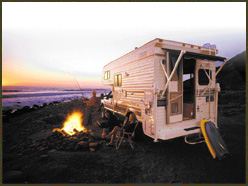We may earn revenue from the products available on this page and participate in affiliate programs. Learn More ›
Getting weathered out on hunting or fishing trips happens to all of us, but how many times has rain or snow forced you to hunker down in a dripping tent or sent you packing for the nearest hotel? Ever wished you could step into a warm, dry place for the night, have a hot meal and still be able to walk out your front door to fish or hunt in the morning? Well, you can when you use an RV as a base camp. Here are the pluses and minuses of each type by price range.
Budget Camping
A fold-down tent trailer is the least expensive option for comfortable camping digs. It offers a tremendous amount of sleeping and living space for the dollar invested.
- +Very inexpensive starter RV. (Prices begin around $4,000 new.)
- +Can be easily towed by almost any vehicle. (Sizes start at about 12 feet folded for travel.)
- +Full-size sleeping space for four to eight adults.
- –Not well enough insulated for extreme cold-weather use.
- –Not as secure when locked up due to tent-fabric sides.
- –More work to set up and break down due to slide-out bed platform ends and tent enclosure.
Slide-In Comfort A slide-in truck camper may be the best RV choice for hunters and fishermen because it leaves your truck free to tow ATVs or a fishing boat.
- +Highly mobile, can be driven to remote camps on a four-wheel-drive pickup.
- + Can be unloaded and left in camp, freeing up the pickup for travel.
- +Insulated for all-season use. Fully equipped for self-contained comfort.
- + Fairly economical to purchase, starting at about $7,000 to $10,000 for a nicely outfitted model.
- –Limited floor space.
–High center of gravity can create uneasy handling on side-tilted roads. Trailer Living
A travel or fifth-wheel trailer is available to suit almost every size of tow vehicle. And with the trailer parked in camp, your truck is free for you to run around in. Trailering ATVs or boats is possible behind a fifth-wheel in some states, but a set of racks on a pickup or on top of a cab-high camper shell can certainly support a lightweight aluminum boat or canoe.+Sizes range from about 16 feet up to 34 feet.
- +Excellent interior living space. (It sleeps four adults minimum.)
- +Hard sides mean higher security when locked up.
- +Affordable prices starting around $9,000 new, or about $4,000 used.
- –Towing an ATV or boat trailer is difficult.
- –Backing into a campsite is a problem for some drivers. A Touch of Class
A motor home is the pinnacle of RV comfort. Most models can easily tow an ATV, boat trailer or 4WD vehicle, and they’re not as difficult to drive as they may seem. They can haul up to eight occupants and many models offer massive storage capacity. These features don’t come cheap, however, which is why these are the most expensive recreational vehicles.
A “Class C” or “mini” motor home, identified by the van-based cab area and cab-over bed, is smaller and cheaper than a Class A but offers amazing living accommodations for its size.
- +Can sleep six to eight adults.
- +Size ranges from 22 to 34 feet, so they’re smaller and more maneuverable than a typical Class A recreational vehicle.
- –Fuel thirsty, averaging 7 to 10 miles per gallon.
- –Full-size coach body can still be somewhat intimidating for some people to drive.
- –Most are only available in two-wheel-drive, which can limit mobility.
- –New prices start at about $50,000 (but many are available used starting at about $10,000).
A “Class B” motor home is typically a full-size van with an extended-fiberglass top for extra headroom. Most Class B units feature complete self-containment feeatures in a very compact package.
- +Very easy to drive and park.
- +Can be used as a family’s everyday vehicle.
- +Can tow an ATV or boat trailer.
- +No larger than a standard van (18 to 22 feet overall).
- +Well-insulated and weatherproof.
- –Relatively expensive for its size.
- –Prices start at about $55,000 new and $10,000 used.
- –Limited sleeping space (normally two adults and sometimes three).
- –Reduced cargo storage and fluid capacities, which limit how long you can camp in a non-hookup location.
A “Class A” motor home is the ultimate in comfort and living accommodations. Most are 2WD, and driving them is easy with a little practice.
Maximum living and storage space, and fluid capacities to handle longer stays in non-hookup locations are among the many Class A advantages.
- +Capacity to comfortably sleep up to eight adults.
- –Fuel-thirsty, averaging six to eight miles per gallon.
- –Large size, 28- to 36-feet long, calls for roomy parking space and somewhat limits your campsite choices.
- –New prices start at about $60,000. Used models can be $15,000 with widely varying appointments.
Match Your Needs
In the end, the RV you choose really depends on your personal needs. Ask yourself, “What do I really want to use this rig for?”
If you intend to leave an RV on your deer lease for an entire season, then a trailer that you need tow to the site only once each year makes sense. (Better yet, you can split the cost of purchasing one with the other buddies on your lease and save.)
If you have a lot of stuff to tow, a slide-in camper frees up the pickup hitch for towing duties, plus you’ll be able to access far more remote areas if you have four-wheel-drive. However, if you’re retired and intend to do a lot of traveling with your wife, family or friends, a motor home may be a better choice.
